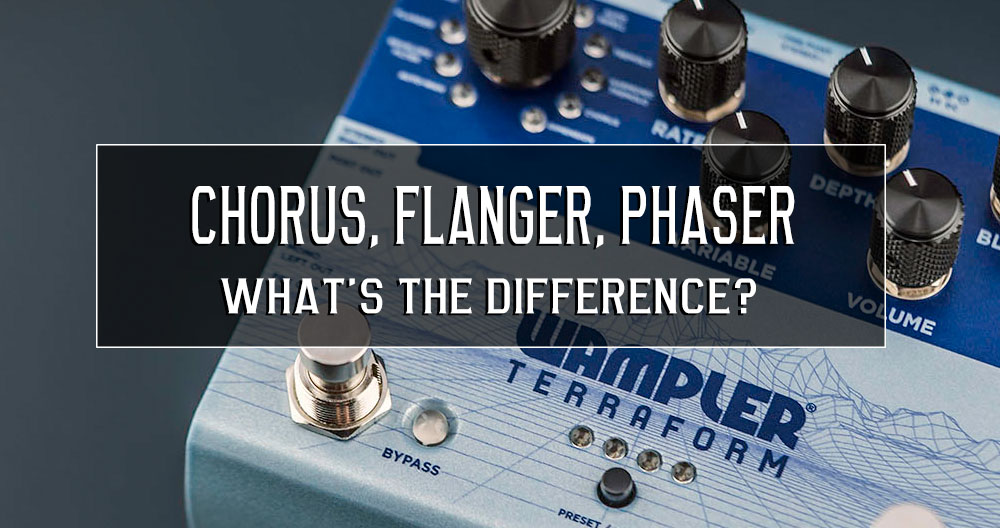
Let’s face it, we’ve all used them before and I imagine that like me you’ve got them confused or not really understand what makes each different. As I started playing properly in the 80’s each of these pedals carry HUGE memories for me and I’ll always have a love/hate relationship with each.
Before we go any further, let’s put on the (my level of) nerd goggles and dig into what separates them. They all come into the family of “modulation”, because… well, they all modulate the signal! Yeah, that doesn’t help much does it… Usually, this means that the signal is in some way split, the something happens to one of the signals and then it is laid back on top of the original one. This creates movement, modulation, and if you go too far, chronic seasickness.
Phaser.
As your signal goes into the pedal, it is instantly split into two. One of those has its phase shifted and then they are laid on top of each other before exiting the pedal. Because you have two opposite phases of the same note sitting within each other, a notch is created where they cancel each other out and then these notches are swept along a range of the frequency band. This where you get that wonderful sweeping ripple.
Name: Phaser Splitter… “Phaser”
Here is my favourite example of a phaser (totally obvious!)
Flanger.
A Flanger is not too dissimilar to a Phaser, but can be much wetter sounding. A flanger happens when the signal is split into 2, one is delayed and then put back on top of the other. The most audibably pleasing Flangers are running at somewhere under 15ms delay, but the rate control changes that. The effect of the flanger going swoooosh is where the delayed signal then has the delay time varied in a constant cycle, up and down.
Name: Legend has it that a producer was running two identical copies of audio and pressed against the flange of the reel to slow one down slightly to make it run ever so slightly out of time… “Flanger”. This is hotly disputed though as George Martin has said that the phrase comes from Lennon during the recording of the Revolver album, Lennon was enquiring about “artificial double tracking” and Martin answered with a nonsense “Now listen, it’s very simple. We take the original image and we split it through a double vibrocated sploshing flange with double negative feedback”. Lennon thought he was joking and Martin responded with “Well, let’s flange it again and see”… Lennon went on to call it “Ken’s Flanger” after Abbey Road engineer Ken Townsend performed the process of copying the vocal line and slightly delaying it. The concept was later expanded into stereo and was first credited to Eddie Kramer during the recording of Axis Bold As Love by Hendrix in 1967.
My favourite flanger example
Chorus.
The one that was TOTALLY overused in the 80’s, hence my love/hate relationship with it. Like the flanger, the signal is split, slightly detuned and then delayed, and put back on top The main difference is that the delay used to create the chorus is somewhat longer, usually between 20-50ms . Chorus was first given to us, the guitar community, in the mid 70’s within the legendary Roland JC120 amp. The Chorus element of this amp was then released as a stand alone unit as the BOSS CE-1. To this day, this is, to many people the ultimate chorus pedal. Personally, I love it, but the best one I’ve ever heard was in a Roland RE-501. Although, it does have to be said, I’ve not physically heard one for well over 20 years, I just remember it being the fattest and most lush chorus I’ve ever heard!
Name: Imagine two large vocal choirs singing as close they can get, you could call it a chorus of vocals… put them wide apart, stand in the middle and because it’s almost impossible to singer perfectly on key and at the same time, when they are separated it provides the chorus effect.
One of the best uses of chorus I hear is when the rate is set really low and it’s in stereo. You don’t get the movement but you get the width. Brian May live was the best I’d heard this used, it was so massive I can’t describe it.
Here is my favourite example of regular Chorus
A dimension chorus differs in that it creates two clones of the original signal, both are delayed and then one is flipped 180-degress and then laid back on top. This gives a much bigger effect.. the most interesting thing for me is that the Dimension C pedal gives you four options, which just changed the regular controls… was this the first boss with presets?
My favourite example of Dimension Chorus (once again, totally obvious!)
It’s well worth noting the difference between vibrato and tremolo. Because, well, I don’t know why, in the early days Fender appeared to get these two names the wrong way round, a lot of effect pedals are still incorrectly named. Vibrato changes the pitch of the signal, tremolo dips the volume up and down! One modulates the pitch, one modulates the volume… So, your trem bar, it’s actually a vibrato bar. Or to give it the correct name, the whammy bar!



Thanks for this. I’ve always wondered but been too afraid to ask!
😁